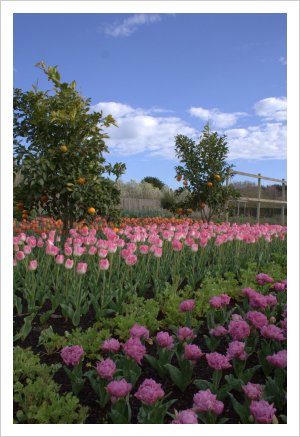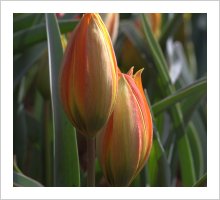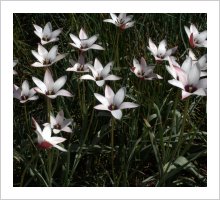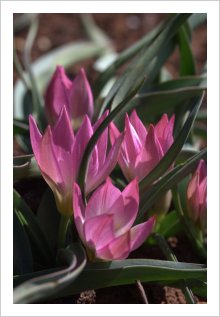Easy Care Tulip Species
It wasn’t the Dutch who first cultivated tulips but the Ottomans in Istanbul. It was from there that bulbs were taken to Belgium in the late 16th century and then on to the Netherlands. Holland now produces three billion tulip bulbs a year and exports one billion, many to Australia, for commercial cut flower production.
 Central Victoria and temperate regions of inland Australia have a much more suitable climate for growing these bulbs and, unlike in Holland where tulip bulbs have to be lifted and replanted every year, they are quite happy left in the garden for many years where they increase and flower freely.
Central Victoria and temperate regions of inland Australia have a much more suitable climate for growing these bulbs and, unlike in Holland where tulip bulbs have to be lifted and replanted every year, they are quite happy left in the garden for many years where they increase and flower freely.
One group of the copper-orange flowered Tulipa whittallii, a native of south western Turkey, has been flourishing in the same spot in my garden for twenty years. From an original planting of half a dozen bulbs it now numbers in the hundreds. In our dry climate garden this tulip flowers at the same time as the lime green flowered spurge, Euphorbia myrsinites, with which it shares a similar rocky habitat in Turkey.
A favourite species is Tulipa clusiana, the Lady tulip, with exquisitely shaped white flowers stained reddish pink on the outside. It hails from Kashmir, Pakistan, Afghanistan and Iran but was brought into cultivation in the west centuries ago and has naturalised in southern Europe. Like all of its kind it needs a well drained position, which gets full sun during winter and early spring, and then a good dry summer rest period. I have it growing under a carpet of drought tolerant thyme, Thymus longicaulis ssp chaubadii, which is a native of Crete.
 |
 |
 |
| Tulipa whittalii | Tulipa clusiana | Tulipa kauffmaniana |
The smallest of all tulips is Tulips aucheriana, a species which is endemic to a couple of areas in Iran, one site is near Teheran and the other near Isfahan. Threatened in the wild it has fortunately settled happily in my garden and increases well. Its flower stem is no more than 5cm tall and the  mauve-pink flower is about the size of a 10 cent coin. I grow it in a small rock garden, under a blue-metal mulch, where it gets a good summer baking.
mauve-pink flower is about the size of a 10 cent coin. I grow it in a small rock garden, under a blue-metal mulch, where it gets a good summer baking.
Altogether I grow around thirty tulip species, the first to flower is Tulipa kauffmaniana, the Water Lily Tulip from Uzbekistan which begins to bloom in August and the last to flower is Tulipa sprengeri, from northern Turkey, which doesn’t get going until November.
The majority of tulip species flower in September which is also the time the Dutch hybrid tulips are at their best. These wonders of the horticultural world, the culmination of four hundred years of assiduous breeding by generations of Dutch growers, are displayed in the traditional way here at Lambley. Every April we plant 6,000 tulip bulbs in the vegetable garden. They are planted in blocks of 500 of each variety separated by a 40cm wide band of small flowered, mixed Ranunculus. The Ranunculus start to bloom in October, just as the tulips are going over, and carry the bedding display on into November when all the bulbs are dug to make way for summer annuals.
This article first appeared in the Quarterly Magazine of the Garden Clubs of Australia, Our Gardens